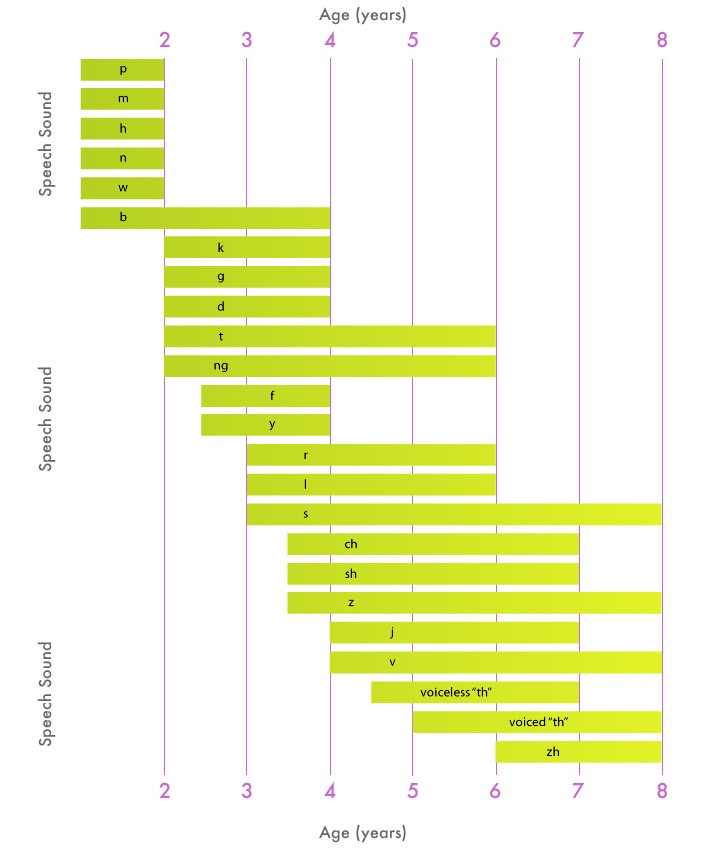Here is a speech chart I use to show families about speech sound development…

Bars show 50% (start of bar) – 90% achieved (end of bar) Early 8- m, b, y, n, w, d, p, h Middle 8- t, k, g, ng, f, v, ch, j Late 8- sh, s, z, l, r, th (voiced and voiceless), zh Source: Sander, Erik K. “When Are Speech Sounds Learned?” JSHD, 37 (February 1972).
The start of the bar is where 50% of children have accomplished the particular sound (at the start, middle and end of words) and the final bar is where 90% of children have accomplished the sound. There are a range of charts around with some differences but the majority have the same groupings of speech sounds.
Why is a chart like this helpful?
- A milestone chart can help you to answer the question ‘is this sound that my child can’t say typically not used by other children their age?’
- It can prompt you to seek professional reassurance or advice from a Speech-Language Therapist. Sometimes professional advice may occasionally be to wait for therapy… but usually there are strategies that can be used to support sound development so that therapy may not be needed in future. If you wait, you may well have wasted time if therapy would have been necessary back when you first thought about seeking help.
- I like to use the norms as a guideline for which sounds a child might be ready for next (no point working on ‘r’ if they haven’t yet got ‘k’), though usually the best sound for a child to work on is one that they are ‘stimulable’ for (meaning they can say the sound by itself or can easily be taught the sound).
Why is a chart like this not helpful?
- In my opinion, it’s easy to get caught up in meeting or exceeding ‘normal’. Speech development is not a competition, and many factors can mean that a child is a bit further behind in their development e.g. a history of glue ear, language delay. It’s not really fair to expect a child with a history of these difficulties to be developmentally on par with peers. However, we might need to give children with a history of difficulties a head start rather than wait and see. Again, there are strategies that can be used to support sound development so please don’t just think that your child will catch up in their own time.
- Another difficulty is that some sounds might be in a child’s repertoire, but not be articulated correctly. For example lateral sounds (like the slushy sounds that Sid uses in the Ice Age movies). When sounds are not articulated correctly, it’s rare that these would fix up all by themselves.
- We also have to think about ‘intelligibility.’ If there are many sounds in error, it can make it really hard to understand a child. Regardless of whether their speech is ‘typically developing’, if you cannot understand much of what your child is saying, seeking support to find ways to improve sound development will be highly valuable.
- Another consideration is what particular sounds are changed to e.g. ‘f’ to ‘b’ is a typical but a delayed pattern if it goes on too long. However, ‘f’ changed to ‘s’ is not a typical pattern so would be considered ‘disordered’. You aren’t expected to know about all of these sound patterns though!
Each child is an individual and it is best to consider how speech errors are affecting their communication, interactions, and how much it is bothering them. If a child is starting to avoid talking, say ‘nevermind’ if they can’t be understood, or showing frustration that they aren’t understood, it’s a good time to address their speech – regardless of what a chart might say. If other’s (e.g. preschool teachers, family) share they have concerns about your child’s speech, and you are noticing their speech is not as easy to understand compared to peers, feel free to call me about your child’s speech development.

